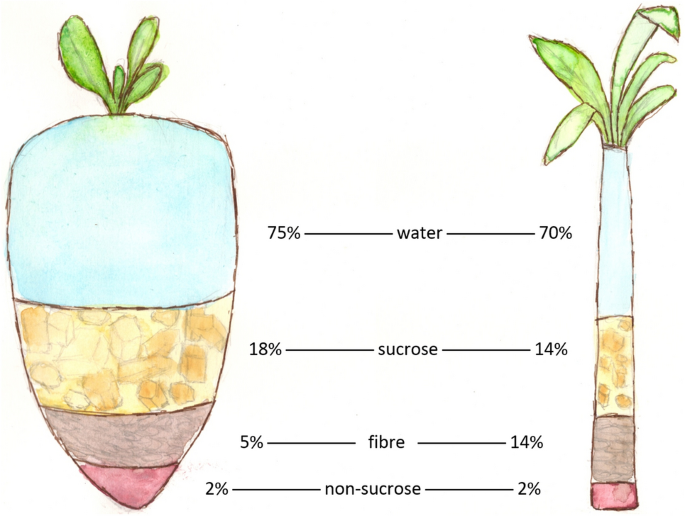Discover the Uses and Perks of Beet Sugar Vs Cane Sugar in Your Daily Diet
Exploring the distinctive high qualities of beet and cane sugar reveals even more than simply their sweetening abilities; it highlights their unique influence on wellness and cookeries. Beet sugar, understood for its subtle flavor, is often favored in fragile treats, whereas cane sugar, with its tip of molasses, includes richness to robust meals. Each type holds its own nutritional account and glycemic effects, welcoming a deeper understanding of their roles in a well balanced diet and lasting consumption techniques.
Origin and Production Procedures of Beet and Cane Sugar

The distinctive environments and dirt kinds needed for growing sugar beetroots and sugarcane add to differences in their cultivation techniques and geographical circulation, affecting the economics and sustainability of their manufacturing. beet sugar vs cane sugar.
Nutritional Contrast Between Beet Sugar and Cane Sugar
Despite stemming from different plants, beet sugar and cane sugar are nutritionally extremely comparable, both largely including sucrose. Each provides regarding 4 calories per gram, translating to approximately 16 calories per tsp. Structurally, both sugars are made up of about 99.95% sucrose, with minimal amounts of various other materials like dampness and trace element, which do not dramatically change their dietary accounts.

Eventually, when selecting between beet sugar and cane sugar based on dietary material alone, both offer the same benefits and downsides as they are essentially forms of the same particle-- sucrose, offering fast energy without other nutrients.
Effect On Health And Wellness: Glycemic Index and Caloric Content
Checking out better into the impacts of beet sugar and cane look at these guys sugar on health, it is crucial to consider their glycemic index and caloric content. The glycemic index (GI) of both beet and cane sugar is around 65, classifying them as high-GI foods, which can create quick spikes in blood sugar levels.
Each kind of sugar contains around 4 calories per gram, making their calorie content equivalent. For those keeping an eye on caloric intake, particularly when managing weight or metabolic health problems, comprehending this equivalence is essential (beet sugar vs cane sugar). Too much consumption of any high-calorie, high-GI food can add to wellness problems such as weight problems, heart disease, and insulin resistance.
Environmental and Economic Considerations of Sugar Manufacturing
Beyond health and wellness effects, the production of beet and cane sugar also raises substantial environmental and financial issues. Sugar beet growing has a tendency to need cooler climates and has a reduced geographical footprint contrasted to sugar cane, which prospers in tropical areas. However, both plants are intensive in terms of water usage and land occupation, possibly causing deforestation and water scarcity. Financially, the global sugar market is very unpredictable, influenced by changes in global profession policies and subsidies. Numerous countries incentivize sugar production through economic assistance, skewing market value and influencing small-scale farmers negatively.
In addition, making use of pesticides and fertilizers in both beet and cane sugar cultivation can cause soil deterioration and pollution, more impacting biodiversity and neighborhood water you can look here bodies (beet sugar vs cane sugar). The choice in between cultivating sugar beet or cane usually depends upon regional ecological conditions and financial factors, making the sustainability of sugar manufacturing a complex issue
Culinary Applications and Flavor Differences
While Web Site the ecological and economic aspects of sugar manufacturing are undoubtedly considerable, the option between beet and cane sugar also affects cooking applications and flavor profiles. Beet sugar, acquired from the sugar beet plant, is understood for its remarkably neutral preference.
Walking cane sugar, removed from sugarcane, frequently preserves molasses traces, which impart a distinctive splendor and deepness. The slight variation in moisture material in between beet and cane sugar can affect the structure and consistency of meals, making cane sugar a recommended selection for particular recipes that profit from its unique residential properties.

Conclusion
Finally, both beet and cane sugar have distinctive beginnings and manufacturing processes, providing comparable dietary profiles with slight distinctions in salt material and flavor. While their effect on health and wellness, especially concerning glycemic index and calories, is similar, the choice between them often comes down to ecological, financial aspects, and particular culinary demands. Understanding these aspects can lead customers in making notified decisions that align with their wellness goals and taste choices.